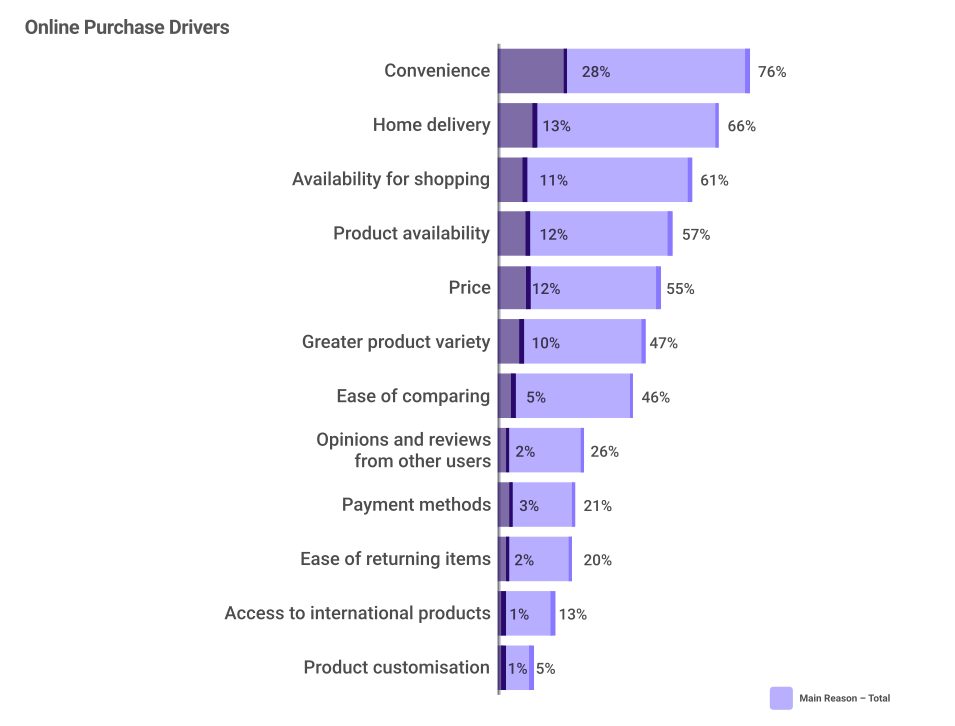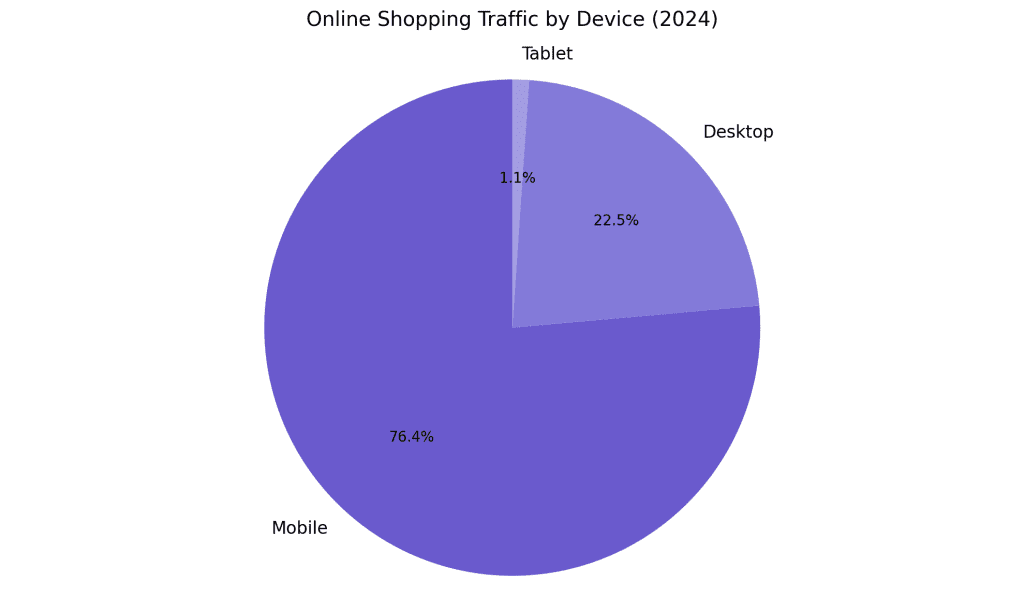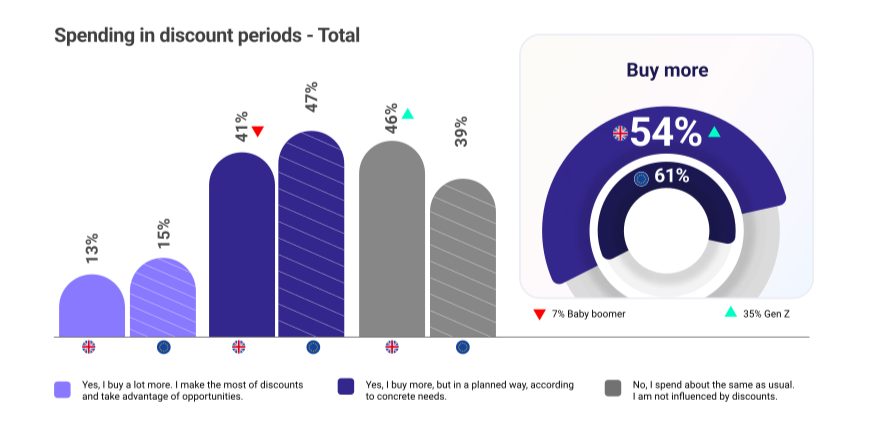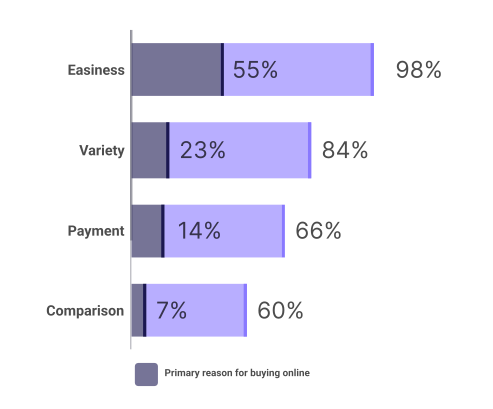Online shopping isn’t just a trend—it’s a way of life. With 81% of UK consumers shopping online more than once a month and spending an average of £89 monthly, digital commerce is now embedded in everyday routines. But why do people shop online so frequently? What makes eCommerce not just a viable alternative but the preferred choice for millions?
At Doofinder, we’ve delved deep into the data from recent reports, including our latest Online Consumer Landscape, to uncover the 12 most compelling reasons. From convenience to comparison tools, here’s a breakdown of the benefits of online shopping—and why consumers prefer to shop online.

Top 12 Reasons People Shop Online
From convenience to comparison tools, consumers know exactly what they want from eCommerce—and why they keep coming back. Based on our latest research, these are the top 12 reasons consumers prefer to shop online.

1. Convenience Is King
When asked what is the top reason why customers purchase online, the answer is clear: convenience leads the pack. According to our study, 76% of UK consumers cite convenience as a key reason they shop online, and 28% name it their number one driver—more than double any other factor.
What does “convenience” mean to today’s shoppers? It’s the ability to browse and buy on your own schedule, without queues, closing hours, or the need to leave the house. This also includes fast site navigation, easy search tools, and one-click checkout options.
Convenience means more than just having an eCommerce site—it’s about making it easy to use. A smart search tool like Doofinder can boost conversions by up to 20%. Try Doofinder free for 30 days.
2. Home Delivery Saves Time
Next to convenience, home delivery is a major factor, chosen by 66% of consumers. It’s not just about comfort—it’s about efficiency. With express delivery and real-time tracking, customers now expect products at their doorstep in record time. In fact, 55% are willing to pay for same-day delivery, and 45% for next-day delivery, underscoring the growing demand for speed in eCommerce (Meteorspace, 2025).
3. 24/7 Shopping Availability
No closing hours here. 61% of online shoppers appreciate the ability to browse and buy outside traditional store hours, making late-night or weekend shopping possible. Plus, with mobile accounting for 76,42% of eCommerce sales, consumers are increasingly making purchases on the go, whenever and wherever it’s convenient for them.

4. Product Availability
Product availability came in at 57%. This is largely due to the limited shelf space in physical stores, which typically carry between 15,000 and 60,000 items. In comparison, online retailers can list over 200,000 products, allowing them to stock a much wider variety—including niche or slower-selling items. That flexibility makes a big difference in ensuring shoppers find what they’re looking for.
Curious why many still prefer shopping in-store? Check out the advantages of offline shopping.
5. Price is a Motivator
Price isn’t everything, but it’s always in play. While only 12% of consumers list it as their top reason for shopping online, 55% say it’s an important consideration overall. Deals, discounts, and sales are powerful motivators—70% of online shoppers say they’re influenced by promotional pricing.
Gen Z and Millennials are especially responsive to offers, actively hunting for the best bang for their buck.

6. Greater Product Variety
From global brands to hyper-niche products, 47% of online shoppers value the variety that eCommerce platforms provide.
With no shelf-space limits, online stores can stock 5–10 times more items than physical shops—giving access to everything from artisan crafts to global tech. This endless selection makes it easier for shoppers to discover unique or hard-to-find items. It’s a key reason why many prefer browsing online over visiting a store.
At this point, it’s clear that the first six reasons consumers shop and buy online are rooted in convenience, variety, speed, and transparency—each contributing to the modern digital shopping experience.
7. Ease of Comparing
Shopping online makes it super easy to compare products. While only 5% of shoppers say it’s their top reason for buying online, nearly 46% admit it heavily influences their choices.
With built-in comparison tools, smart filters, and detailed specs at your fingertips, it’s no wonder people feel more confident clicking ‘buy.’ In fact, studies show that shoppers who compare products are 2–3 times more likely to complete a purchase.
8. Opinions and Reviews from Other Users
Online, trust is built through transparency. While just 2% say reviews are their #1 factor, 26% rely on the opinions of other buyers to guide their choices.
It’s the power of social proof: consumers trust real user feedback more than polished marketing. Reviews, testimonials, and star ratings often become the final push toward purchase.
9. Payment Methods & Flexibility
One size doesn’t fit all—especially at checkout. 21% of shoppers prioritise having access to their preferred payment methods, and 39% use installment plans for big-ticket items.
Top payment preferences include:
- PayPal
- Buy Now, Pay Later (BNPL)
- Mobile wallets like Apple Pay or Google Pay
The more flexible the checkout, the lower the cart abandonment rate.
10. Ease of Returning Items
Online purchases come with uncertainty—but flexible return policies make all the difference. 20% of shoppers say that easy returns influence their decision to buy, especially for items like clothes and electronics. Interestingly, Baby Boomers are more likely than other generations to prioritise return processes.
11. Access to International Products
Cross-border eCommerce is on the rise. While only 1% say it’s their main motivator, 13% of shoppers in the UK cite access to global products as a key reason they shop online—rising to 20% among Gen Z.
For younger consumers especially, shopping online is a gateway to global trends and hard-to-find items that local retailers just don’t carry.

12. Product Customisation Is Small—but Growing
Personalisation is still a niche driver—just 5% overall consider it a key factor—but its influence is rising.
Among Gen Z shoppers, 18% are motivated by the ability to customize products to fit their personal style, preferences, or needs. Whether it’s size, colour, engraving, or design, shoppers want more say in what they buy, and how it reflects them.
We also wrote an interesting article on our findings on Gen Z consumer behavior.
The Core Benefits of Online Shopping: What Matters Most

After analysing the top 12 reasons why people shop online, one thing becomes clear: the benefits of online shopping group naturally into four dominant themes—each one shaping modern eCommerce expectations.
According to Doofinder’s 2025 Online Consumer Landscape report:
- 98% of consumers are motivated by factors related to easiness—from convenience and delivery to flexibility in returns. It’s the undisputed top driver.
- 84% value variety, including better product availability, global access, and broader catalogues than physical stores.
- 66% highlight payment-related benefits, including price sensitivity and flexible methods like BNPL.
- 60% are driven by comparison tools, especially price and review transparency.
These “Big Four” benefits explain not just why consumers prefer to shop online, but also how brands can meet rising expectations. What matters now isn’t just having the product—it’s about making the journey frictionless, informative, and tailored to each shopper.
Final Thoughts
So, why do people shop online? Because it’s smart, fast, personal, and loaded with value. From Millennials making 80% of their purchases online to Boomers appreciating simple navigation and return policies, the reasons are as diverse as the shoppers themselves.
As eCommerce continues to evolve, platforms that understand these motivations, and meet them with speed, intelligence, and personalization, will be the ones that win.
Ready to unlock the full power of online shopping benefits? Doofinder is your digital sales assistant—guiding users to the right product, at the right time, effortlessly.
Want the full scoop on the online eCommerce landscape? Read the full report for free by clicking on the button below.









